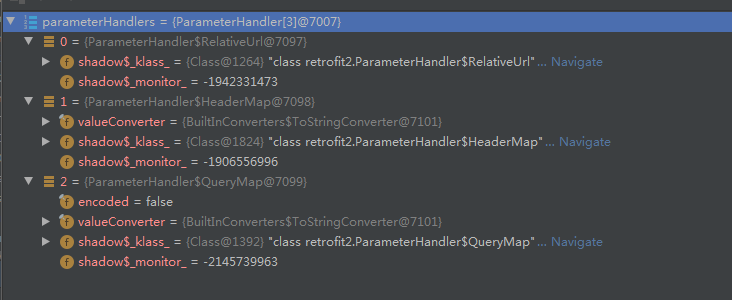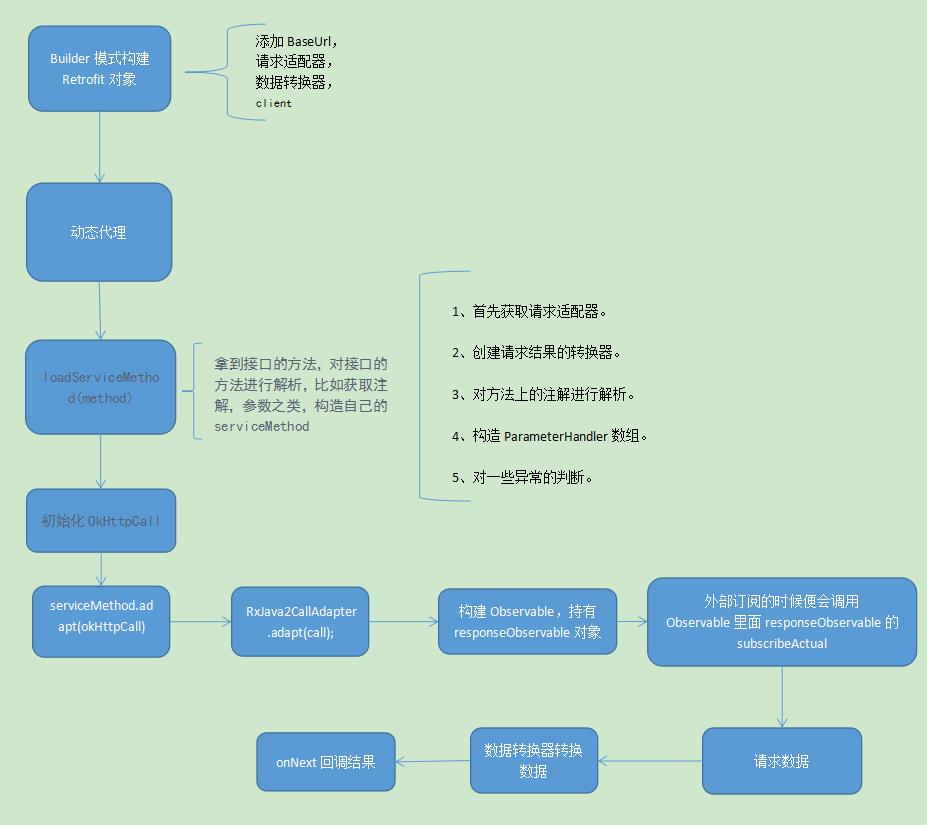RxJava + Retrofit源码解析
RxJava + Retrofit怎么请求网络,具体的用法这里就不讲了,本文只讲一些重点源码。
版本如下:
okhttp : "com.squareup.okhttp3:okhttp:3.10.0",
okhttp3_integration : "com.github.bumptech.glide:okhttp3-integration:1.4.0@aar",
retrofit : "com.squareup.retrofit2:retrofit:2.4.0",
converter_gson : "com.squareup.retrofit2:converter-gson:2.3.0",
converter_scalars : "com.squareup.retrofit2:converter-scalars:2.3.0",
converter_protobuf : "com.squareup.retrofit2:converter-protobuf:2.3.0",
adapter_rxjava2 : "com.squareup.retrofit2:adapter-rxjava2:2.2.0",
logging_interceptor : "com.squareup.okhttp3:logging-interceptor:3.10.0",
rxjava : "io.reactivex.rxjava2:rxjava:2.1.12",
rxandroid : "io.reactivex.rxjava2:rxandroid:2.0.2",
一、首先关于Retrofit的初始化:
private void initRetrofit() {
ExtensionRegistry extensionRegistry = ExtensionRegistry.newInstance();
retrofit = new Retrofit.Builder()
.baseUrl(baseUrl) //设置地址
.client(client.build()) //设置自定义的OkHttpClient
.addConverterFactory(ProtoConverterFactory.createWithRegistry(extensionRegistry))
.addConverterFactory(StringConverterFactory.create())
.addConverterFactory(GsonConverterFactory.create(buildGson()))
.addCallAdapterFactory(RxJava2CallAdapterFactory.create())
.build();
service = retrofit.create(ApiService.class);
}
.addConverterFactory(ProtoConverterFactory.createWithRegistry(extensionRegistry))
.addConverterFactory(StringConverterFactory.create())
.addConverterFactory(GsonConverterFactory.create(buildGson()))
.addCallAdapterFactory(RxJava2CallAdapterFactory.create())
添加了数据转换器与请求适配器。
Retrofit的初始化采用了Builder模式。
Retrofit.Builder()这一步,获取了一个平台,肯定就是Android()了,后面有地方会用到。
Builder(Platform platform) {
this.platform = platform;
}
public Builder() {
this(Platform.get());
}
class Platform {
private static final Platform PLATFORM = findPlatform();
static Platform get() {
return PLATFORM;
}
private static Platform findPlatform() {
try {
Class.forName("android.os.Build");
if (Build.VERSION.SDK_INT != 0) {
return new Android();
}
} catch (ClassNotFoundException ignored) {
}
try {
Class.forName("java.util.Optional");
return new Java8();
} catch (ClassNotFoundException ignored) {
}
return new Platform();
}
}
在看最后的build();方法:
public Retrofit build() {
if (baseUrl == null) {
throw new IllegalStateException("Base URL required.");
}
okhttp3.Call.Factory callFactory = this.callFactory;
if (callFactory == null) {
callFactory = new OkHttpClient();
}
Executor callbackExecutor = this.callbackExecutor;
if (callbackExecutor == null) {
callbackExecutor = platform.defaultCallbackExecutor();
}
// Make a defensive copy of the adapters and add the default Call adapter.
List<CallAdapter.Factory> callAdapterFactories = new ArrayList<>(this.callAdapterFactories);
callAdapterFactories.add(platform.defaultCallAdapterFactory(callbackExecutor));
// Make a defensive copy of the converters.
List<Converter.Factory> converterFactories =
new ArrayList<>(1 + this.converterFactories.size());
// Add the built-in converter factory first. This prevents overriding its behavior but also
// ensures correct behavior when using converters that consume all types.
converterFactories.add(new BuiltInConverters());
converterFactories.addAll(this.converterFactories);
return new Retrofit(callFactory, baseUrl, unmodifiableList(converterFactories),
unmodifiableList(callAdapterFactories), callbackExecutor, validateEagerly);
}
1、如果没有传入我们自定义的OkHttpClient,那么便会使用默认的。
2、如果没有设置自定义的回调执行器,那么便会是用默认的platform.defaultCallbackExecutor();点进入可以发现回调是默认在主线程中的:
static class Android extends Platform {
@Override public Executor defaultCallbackExecutor() {
return new MainThreadExecutor();
}
@Override CallAdapter.Factory defaultCallAdapterFactory(@Nullable Executor callbackExecutor) {
if (callbackExecutor == null) throw new AssertionError();
return new ExecutorCallAdapterFactory(callbackExecutor);
}
static class MainThreadExecutor implements Executor {
private final Handler handler = new Handler(Looper.getMainLooper());
@Override public void execute(Runnable r) {
handler.post(r);
}
}
}
3、把我们设置的请求适配器添加进入,然后再添加一个默认的请求适配器。
4、添加进入一个默认的数据转换器,然后再被我们设置的数据转换器添加进去。
二、初始化好Retrofit后,再来看这一句:
service = retrofit.create(ApiService.class);
ApiService是一个接口,里面方法如下:
@GET
Observable<ResponseBody> doGet(@Url String url, @HeaderMap Map<String, String> headers, @QueryMap Map<String, String> map);
这个create方法可以说是核心,它运用的是动态代理。
@SuppressWarnings("unchecked") // Single-interface proxy creation guarded by parameter safety.
public <T> T create(final Class<T> service) {
Utils.validateServiceInterface(service);
if (validateEagerly) {
eagerlyValidateMethods(service);
}
return (T) Proxy.newProxyInstance(service.getClassLoader(), new Class<?>[] { service },
new InvocationHandler() {
private final Platform platform = Platform.get();
@Override public Object invoke(Object proxy, Method method, @Nullable Object[] args)
throws Throwable {
// If the method is a method from Object then defer to normal invocation.
if (method.getDeclaringClass() == Object.class) {
return method.invoke(this, args);
}
if (platform.isDefaultMethod(method)) {
return platform.invokeDefaultMethod(method, service, proxy, args);
}
ServiceMethod<Object, Object> serviceMethod =
(ServiceMethod<Object, Object>) loadServiceMethod(method);
OkHttpCall<Object> okHttpCall = new OkHttpCall<>(serviceMethod, args);
return serviceMethod.adapt(okHttpCall);
}
});
}
1、首先检测这是否是一个接口,只有接口才能对它进行动态代理。
2、是否需要对接口里面的方法进行初始化预加载,是的话便进行,这个与下面的有点重复,直接讲下面的。
3、return后面的语句便是动态代理的地方,它会代理接口的所有方法,也就是说,当我们调用ApiService的方法的时候,会被拦截,然后走到inoke这个方法做我们自己的操作。
关于动态代理,后面会单独讲。
4、接下来边看invoke方法:
(1)、首先判断该方法是否为Object这个类的方法,如果是,不拦截它,让他走原来的方法。
(2)、platform为Android,platform.isDefaultMethod(method)返回false,不用管它。
(3)、ServiceMethod<Object, Object> serviceMethod =(ServiceMethod<Object, Object>) loadServiceMethod(method);拿到接口的方法,对接口的方法进行解析,比如获取注解,参数之类,构造自己的serviceMethod
(4)、初始化OkHttpCall
(5)、调用serviceMethod.adapt(okHttpCall)进行请求(因为采用的是RxJava,所以这里并不会立即请求,只有被订阅的时候才会,等会会讲)
三、loadServiceMethod(method)方法:
构造自己的serviceMethod 也采用了Builder模式。
进入这个方法后,重点的一句:
result = new ServiceMethod.Builder<>(this, method).build();
先看:
Builder(Retrofit retrofit, Method method) {
this.retrofit = retrofit;
this.method = method;
this.methodAnnotations = method.getAnnotations();
this.parameterTypes = method.getGenericParameterTypes();
this.parameterAnnotationsArray = method.getParameterAnnotations();
}
注:我们这里以前面定义的方法来讲解:
@GET
Observable<ResponseBody> doGet(@Url String url, @HeaderMap Map<String, String> headers, @QueryMap Map<String, String> map);
1、持有retrofit与原始的method对象。
2、获取方法上的注解,获取到的为:

3、获取参数类型,获取到的为:

4、获取参数上面的的注解,获取到的为:

再看build()方法:
public ServiceMethod build() {
callAdapter = createCallAdapter();
responseType = callAdapter.responseType();
if (responseType == Response.class || responseType == okhttp3.Response.class) {
throw methodError("'"
+ Utils.getRawType(responseType).getName()
+ "' is not a valid response body type. Did you mean ResponseBody?");
}
responseConverter = createResponseConverter();
for (Annotation annotation : methodAnnotations) {
parseMethodAnnotation(annotation);
}
if (httpMethod == null) {
throw methodError("HTTP method annotation is required (e.g., @GET, @POST, etc.).");
}
if (!hasBody) {
if (isMultipart) {
throw methodError(
"Multipart can only be specified on HTTP methods with request body (e.g., @POST).");
}
if (isFormEncoded) {
throw methodError("FormUrlEncoded can only be specified on HTTP methods with "
+ "request body (e.g., @POST).");
}
}
int parameterCount = parameterAnnotationsArray.length;
parameterHandlers = new ParameterHandler<?>[parameterCount];
for (int p = 0; p < parameterCount; p++) {
Type parameterType = parameterTypes[p];
if (Utils.hasUnresolvableType(parameterType)) {
throw parameterError(p, "Parameter type must not include a type variable or wildcard: %s",
parameterType);
}
Annotation[] parameterAnnotations = parameterAnnotationsArray[p];
if (parameterAnnotations == null) {
throw parameterError(p, "No Retrofit annotation found.");
}
parameterHandlers[p] = parseParameter(p, parameterType, parameterAnnotations);
}
if (relativeUrl == null && !gotUrl) {
throw methodError("Missing either @%s URL or @Url parameter.", httpMethod);
}
if (!isFormEncoded && !isMultipart && !hasBody && gotBody) {
throw methodError("Non-body HTTP method cannot contain @Body.");
}
if (isFormEncoded && !gotField) {
throw methodError("Form-encoded method must contain at least one @Field.");
}
if (isMultipart && !gotPart) {
throw methodError("Multipart method must contain at least one @Part.");
}
return new ServiceMethod<>(this);
}
1、首先获取请求适配器。
2、创建请求结果的转换器。
3、对方法上的注解进行解析。
4、构造ParameterHandler数组。
5、对一些异常的判断。
四、我们接下来对每一步进行讲解。
1、首先获取请求适配器:
private CallAdapter<T, R> createCallAdapter() {
Type returnType = method.getGenericReturnType();
if (Utils.hasUnresolvableType(returnType)) {
throw methodError(
"Method return type must not include a type variable or wildcard: %s", returnType);
}
if (returnType == void.class) {
throw methodError("Service methods cannot return void.");
}
Annotation[] annotations = method.getAnnotations();
try {
//noinspection unchecked
return (CallAdapter<T, R>) retrofit.callAdapter(returnType, annotations);
} catch (RuntimeException e) { // Wide exception range because factories are user code.
throw methodError(e, "Unable to create call adapter for %s", returnType);
}
}
(1)、获取方法的返回类型,返回类型不能是void
(2)、获取方法上的注解。
(3)、调用retrofit.callAdapter(returnType, annotations)方法获取请求的适配器。(我们之前设置的请求适配器都在retrofit对象中)
里面关键的一步为:
int start = callAdapterFactories.indexOf(skipPast) + 1;
for (int i = start, count = callAdapterFactories.size(); i < count; i++) {
CallAdapter<?, ?> adapter = callAdapterFactories.get(i).get(returnType, annotations, this);
if (adapter != null) {
return adapter;
}
}
skipPast为null,所以start为0;
遍历我们之前设置给它的请求适配器,根据返回类型与方法上的注解去找,找到了便返回。(我们这里获取到的callAdapter为RxJava2CallAdapter)
2、创建请求结果的转换器:
responseConverter = createResponseConverter()
这个与获取请求的适配器的过程是类似的,因此这里就略过了。
3、解析方法上的注解:parseMethodAnnotation(annotation),我们用的是GET,所以下面会调用:
parseHttpMethodAndPath("GET", ((GET) annotation).value(), false);
我们这里value是空的,所以它只走了下面这些就返回了。
if (this.httpMethod != null) {
throw methodError("Only one HTTP method is allowed. Found: %s and %s.",
this.httpMethod, httpMethod);
}
this.httpMethod = httpMethod;
this.hasBody = hasBody;
if (value.isEmpty()) {
return;
}
4、构造ParameterHandler数组
int parameterCount = parameterAnnotationsArray.length;
parameterHandlers = new ParameterHandler<?>[parameterCount];
for (int p = 0; p < parameterCount; p++) {
Type parameterType = parameterTypes[p];
if (Utils.hasUnresolvableType(parameterType)) {
throw parameterError(p, "Parameter type must not include a type variable or wildcard: %s",
parameterType);
}
Annotation[] parameterAnnotations = parameterAnnotationsArray[p];
if (parameterAnnotations == null) {
throw parameterError(p, "No Retrofit annotation found.");
}
parameterHandlers[p] = parseParameter(p, parameterType, parameterAnnotations);
}
主要是这一个方法:
parameterHandlers[p] = parseParameter(p, parameterType, parameterAnnotations);
p为序号,parameterType为方法的参数类型,parameterAnnotations为参数的注解。
里面就不细讲了,这里最终得到的是:

对于一些异常的判断就不多讲了,比如:
不能有多个带@Url注解的参数。
不能同时使用@Path与@Url注解。
被@QueryMap标注的参数类型必须是Map
@QueryMap注解的参数的key必须是String
至此,我们的ServiceMethod便构造完了。
五、我们回到代理的那个方法里面,还差两句没有解析:
OkHttpCall<Object> okHttpCall = new OkHttpCall<>(serviceMethod, args);
return serviceMethod.adapt(okHttpCall);
主要看serviceMethod.adapt(okHttpCall)
T adapt(Call<R> call) {
return callAdapter.adapt(call);
}
这里的callAdapter是RxJava2CallAdapter。
于是我们来到它的adapter方法:
@Override public Object adapt(Call<R> call) {
Observable<Response<R>> responseObservable = isAsync
? new CallEnqueueObservable<>(call)
: new CallExecuteObservable<>(call);
Observable<?> observable;
if (isResult) {
observable = new ResultObservable<>(responseObservable);
} else if (isBody) {
observable = new BodyObservable<>(responseObservable);
} else {
observable = responseObservable;
}
if (scheduler != null) {
observable = observable.subscribeOn(scheduler);
}
if (isFlowable) {
return observable.toFlowable(BackpressureStrategy.LATEST);
}
if (isSingle) {
return observable.singleOrError();
}
if (isMaybe) {
return observable.singleElement();
}
if (isCompletable) {
return observable.ignoreElements();
}
return observable;
}
首先我们看isAsync,这里为false,为什么呢?我们创建adapter的时候是这样的:
RxJava2CallAdapterFactory.create()
public static RxJava2CallAdapterFactory create() {
return new RxJava2CallAdapterFactory(null, false);
}
第二个参数便是isAsync
1、所以我们创建的responseObservable为CallExecuteObservable<>(call),(同步执行的类)
2、我们创建一个Observable<?> observable,这里创建的是BodyObservable<>(responseObservable),将刚刚创建的responseObservable
传进去。
3、最终将该observable传出去。
service = retrofit.create(ApiService.class);
public interface ApiService {
@GET
Observable<ResponseBody> doGet(@Url String url, @HeaderMap Map<String, String> headers, @QueryMap Map<String, String> map);
}
service.doGet(url, header, params?.params)
也就是说,当我们调用service.doGet的时候,会走到代理的invoke方法,然后返回一个Observable
而该Observable只有在被订阅的时候才会执行,而且我们用的是同步,所以还需要在外面自己切换到子线程执行。
当被订阅的时候,该BodyObservable会调用subscribeActual:
BodyObservable(Observable<Response<T>> upstream) {
this.upstream = upstream;
}
@Override protected void subscribeActual(Observer<? super T> observer) {
upstream.subscribe(new BodyObserver<T>(observer));
}
而这个upstream便是刚刚传进去的responseObservable,调用subscribe方法,最终会执行到responseObservable的subscribeActual方法。
@Override protected void subscribeActual(Observer<? super Response<T>> observer) {
// Since Call is a one-shot type, clone it for each new observer.
Call<T> call = originalCall.clone();
observer.onSubscribe(new CallDisposable(call));
boolean terminated = false;
try {
Response<T> response = call.execute();
if (!call.isCanceled()) {
observer.onNext(response);
}
if (!call.isCanceled()) {
terminated = true;
observer.onComplete();
}
} catch (Throwable t) {
Exceptions.throwIfFatal(t);
if (terminated) {
RxJavaPlugins.onError(t);
} else if (!call.isCanceled()) {
try {
observer.onError(t);
} catch (Throwable inner) {
Exceptions.throwIfFatal(inner);
RxJavaPlugins.onError(new CompositeException(t, inner));
}
}
}
}
我们主要看Response<T> response = call.execute();call便是我们传进来的自定义的OkHttpCall
在call.execute()里面:
.
.
.
call = rawCall;
if (call == null) {
try {
call = rawCall = createRawCall();
} catch (IOException | RuntimeException | Error e) {
throwIfFatal(e); // Do not assign a fatal error to creationFailure.
creationFailure = e;
throw e;
}
}
.
.
.
return parseResponse(call.execute());
createRawCall()获取okhttp3.Call,call.execute()便是okhttp的网络请求了。
我们主要看怎么获取okhttp3.Call,以及对请求结果的解析parseResponse方法。
private okhttp3.Call createRawCall() throws IOException {
okhttp3.Call call = serviceMethod.toCall(args);
if (call == null) {
throw new NullPointerException("Call.Factory returned null.");
}
return call;
}
ServiceMethod里面:
/** Builds an HTTP request from method arguments. */
okhttp3.Call toCall(@Nullable Object... args) throws IOException {
RequestBuilder requestBuilder = new RequestBuilder(httpMethod, baseUrl, relativeUrl, headers,
contentType, hasBody, isFormEncoded, isMultipart);
@SuppressWarnings("unchecked") // It is an error to invoke a method with the wrong arg types.
ParameterHandler<Object>[] handlers = (ParameterHandler<Object>[]) parameterHandlers;
int argumentCount = args != null ? args.length : 0;
if (argumentCount != handlers.length) {
throw new IllegalArgumentException("Argument count (" + argumentCount
+ ") doesn't match expected count (" + handlers.length + ")");
}
for (int p = 0; p < argumentCount; p++) {
handlers[p].apply(requestBuilder, args[p]);
}
return callFactory.newCall(requestBuilder.build());
}
方法主要是构造了request然后使用okhttp3.Call.Factory创建okhttp3.Call,而我们之前在构建ServiceMothod的构造的ParameterHandler<Object>[] handlers便参与了request的构建,主要是将之前解析到的参数,比如路径,头部信息等添加到request里面。
再看一下请求结果的解析parseResponse方法:
重点语句:
T body = serviceMethod.toResponse(catchingBody);
在看serviceMethod里面的toResponse方法:
/** Builds a method return value from an HTTP response body. */
R toResponse(ResponseBody body) throws IOException {
return responseConverter.convert(body);
}
这里便用到了我们之前设置的数据转换器,对结果进行转换。
以上便是大概的过程了。

转载请标明:https://www.cnblogs.com/tangZH/p/13723480.html
RxJava + Retrofit源码解析的更多相关文章
- Retrofit源码解析(上)
简介Retrofit是Square公司开发的一款针对Android网络请求的框架,官网地址http://square.github.io/retrofit/ ,在官网上有这样的一句话介绍retrofi ...
- Retrofit源码解析(下)
接着上一章继续分析上一章主要简单说了一下基本使用和注解,这一章,我们主要看源码,废话不多说了,直接上.先上一张图 从网络上拿来的 前面一章说了一下Retrofit的简单使用https://www.cn ...
- Retrofit源码设计模式解析(上)
Retrofit通过注解的方法标记HTTP请求参数,支持常用HTTP方法,统一返回值解析,支持异步/同步的请求方式,将HTTP请求对象化,参数化.真正执行网络访问的是Okhttp,Okhttp支持HT ...
- Retrofit源码设计模式解析(下)
本文将接着<Retrofit源码设计模式解析(上)>,继续分享以下设计模式在Retrofit中的应用: 适配器模式 策略模式 观察者模式 单例模式 原型模式 享元模式 一.适配器模式 在上 ...
- 【转载】retrofit 2 源码解析
retrofit 官网地址:http://square.github.io/retrofit/ retrofit GitHub地址:https://github.com/square/retrofit ...
- Retrofit源码分析(一)
1.基本用法 创建接口 public interface GitHubService { @GET("users/{user}/repos") Observable<List ...
- Retrofit2 源码解析
原文链接:http://bxbxbai.github.io/2015/12/13/retrofit2-analysis/ 公司里最近做的项目中网络框架用的就是Retrofit,用的多了以后觉得这个框架 ...
- Retrofit2.0源码解析
欢迎访问我的个人博客 ,原文链接:http://wensibo.net/2017/09/05/retrofit/ ,未经允许不得转载! 今天是九月的第四天了,学校也正式开学,趁着大学最后一年的这大好时 ...
- Java生鲜电商平台-SpringCloud微服务架构中网络请求性能优化与源码解析
Java生鲜电商平台-SpringCloud微服务架构中网络请求性能优化与源码解析 说明:Java生鲜电商平台中,由于服务进行了拆分,很多的业务服务导致了请求的网络延迟与性能消耗,对应的这些问题,我们 ...
随机推荐
- Java中的序列化Serialable
Java中的序列化Serialable https://blog.csdn.net/caomiao2006/article/details/51588838
- Spring Boot 传参 序列化和反序列化
序列化 反序列化
- Spring IoC 的实现机制?
Spring 中的 IoC 的实现原理就是工厂模式加反射机制. 示例: interface Fruit { public abstract void eat(); } class Apple impl ...
- Zookeeper Watcher 机制 -- 数据变更通知 ?
Zookeeper 允许客户端向服务端的某个 Znode 注册一个 Watcher 监听,当服务 端的一些指定事件触发了这个 Watcher,服务端会向指定客户端发送一个事件通 知来实现分布式的通知功 ...
- jsp报错问题之“使用jstl的c标签choose报错Illegal text inside "c:choose" tag问题”
一.报错 [bessky_it][ERROR][2022-03-25 17:19:07] | PLATFORM | ):[c]鍜孾/com.bessky.pss.portal/purchase/sam ...
- JavaScript的取值小技巧之“中括号[]取值法”
一.简介 做下记录,今天看了一篇很有意思的文章,学到了这个取值的小技巧 正常的话我们一般都是用对象直接去'.'对应的属性名(也就是键值对的键)来获取对应的值 这里记录的是另一种取值方式,他是采用中括号 ...
- validator API文档
如何使用 引入 <script src="../node_modules/jquery/dist/jquery.js"></script> <scri ...
- JavaScript & 6小时了解ES6基本语法
一步一步似爪牙. 前言 学习es6之前我们可能并不知道es6相比es5差距在哪, 但是这并不妨碍我们站在巨人的肩膀上; 程序员就是要乐于尝鲜; 学习es6最终目的是结合es5 一起进行工程项目开发, ...
- Web 开发中 Blob 与 FileAPI 使用简述
本文节选自 Awesome CheatSheet/DOM CheatSheet,主要是对 DOM 操作中常见的 Blob.File API 相关概念进行简要描述. Web 开发中 Blob 与 Fil ...
- 如何形成一个完整的HTML对象
写在前面,本文将同步发布于Blog.掘金.segmentfault.知乎等处,如果本文对你有帮助,记得为我得到我的个人技术博客项目给个star哦. 为何写这篇文章? 你可能做Web开发已经有一段时间, ...
